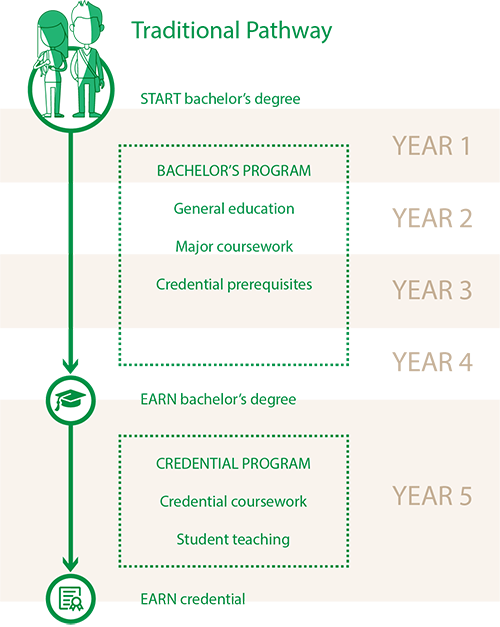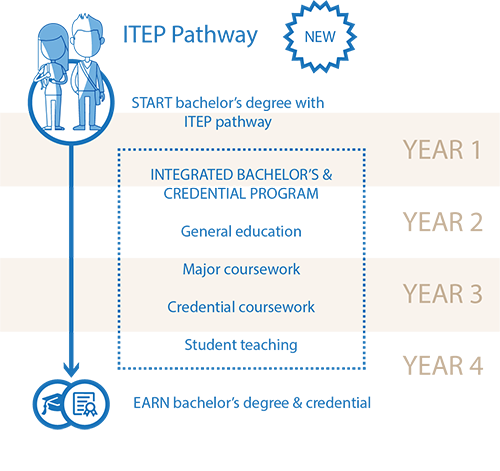
Pathways to Becoming a Social Science Teacher
The Social Science major in preparation for the single subject teaching credential is designed for students who want to pursue a career teaching history, geography, government, and economics in middle and high school. Students take courses in each of the four areas to provides a breadth of knowledge as well as courses on pedagogy.
IMPORTANT NOTE FOR PROSPECTIVE STUDENTS: San Diego State is transitioning away from ITEP programs and replacing them with a new program called "Accelerated Curriculum for Educators" (ACE). The new program will also be a combined bachelor's and credential option. If you are interested in this program, please choose "Social Science, In preparation for the Single Subject Teaching Credential" as your preferred major when you apply to SDSU (we are no longer accepting students into the ITEP program).
Traditional Pathway
The traditional pathway includes a bachelor's degree and a teaching credential in social science and typically takes 5 years.
The first four years, students will take their general education classes and major coursework. After that, students must complete a credential program which includes credential coursework and student teaching; this can be completed in as little as one year.
- DLO1: Utilize a variety of teaching, learning, and assessment strategies that are
appropriate to history/social science, including the appropriate use of instructional
technology.
- DLO2: Analyze how political, intellectual, social, cultural, religious, gendered,
economic, technological, and ecological forces have shaped world history.
- DLO3: Describe the institutions of American and California government, the distribution
of political power across them, and the role of citizens in a representative democracy.
- DLO4: Analyze the major themes and issues in American history and the historical forces
that have shaped them.
- DLO5: Analyze the major themes and issues in California history and the historical
forces that have shaped them.
- DLO6: Identify and analyze the interrelationships between physical, cultural, economic
and environmental influences that shape U.S. regions.
- DLO7: Utilize economic theory to understand how economic forces affect people’s lives and wealth creation within societies.
While some community and junior colleges offer direct equivalents to all of SDSU's major preparation (lower division) courses, you must not assume all are equivalent. Normally you must wait until the transcript evaluators have determined transfer credit (usually during your first semester). If you cannot wait for that determination, reference the SDSU Office of the Registrar’s undergraduate transfer credit page for transfer credit resources and create a Transferology account to determine if agreements exist for your course. For questions, contact the undergraduate advisor at [email protected].
Please contact Christina Weinert at [email protected].

Integrated Teacher Education Program (ITEP) Pathway
The Social Science Integrated Teacher Education Program ITEP is a new 4 year
combined bachelor's and credential option for students who plan to teach history,
government, geography, or economics in middle or high school.
Instead of getting a bachelor's degree and credential separately (five years total), ITEP students earn them together in four years (134 units).
Outcome 1: Recognize and apply global perspectives in the study of history, human culture, geography, government, and economics.
Outcome 2: Comprehend and analyze United States and California history, culture, geography, government, and economics, and of the evolving national experience.
Outcome 3: Use historical interpretation, geographic analysis, economic analysis, and other Social Science methods to examine claims and theories related to society and culture.
Outcome 4: Exhibit the ability to think critically about society and culture, using evidence to analyze and critique social phenomenon.
Outcome 5: Develop the capacity to instruct youth effectively in a classroom setting through creating coherent lesson plans, devising assessment tools, and utilizing effective pedagogical techniques.
Traditionally in California, students earn a undergraduate degree in the subject they want to teach and then enter a one-year teacher credential program. This usually takes 5 years to complete. The ITEP combines the undergraduate degree with the credential into a four year (134 unit) program.
If you are interested in the ITEP program, email the undergraduate adviser, Christina Weinert, at [email protected] to set up an advising appointment. If you are an incoming freshman, choose “social science integrated teacher education program” as your major when you apply to the university.
The ITEP program requires 134 units, so if you enter the university without any units graduating in four years will require taking courses in at least one summer. However, many students enter the university with Advanced Placement or dual enrollment credits, and this often reduces or eliminates the need for summer courses.
If you already have an undergraduate degree in any discipline, you should apply directly to the credential programs at SDSU. Visit the College of Education Office for Student Success for more information.
Yes. When you apply to SDSU, choose “social science ITEP” as your major. Please note that finishing all the upper-division and credential requirements in two years can be challenging, and thus it is highly recommended that you contact the undergraduate advisor at [email protected] as soon as you are admitted to SDSU to plan out your coursework.
Yes. The Dr. Clare B. & Loch Crane, Sr. Endowed Scholarship provides financial support to students who are majoring in the single-subject social science track or who are enrolled in the ITEP program. You can apply through the Aztec Scholarships Portal.
Yes. Students who major in the single-subject track or the ITEP earn a CSET waiver.
No. Students can major in any discipline as an undergraduate and then apply to a credential program. However, the single-subject major is specifically designed to prepare students to teach social science and will cover all the content areas, as well as courses introducing students to pedagogy.
Liberal studies is a major designed for students who want to teach elementary school, and is preparation for a multiple-subjects credential. Social science is for students who want to teach in middle and high schools.
Yes. You may have already taken some social science courses for general education requirements or your previous major, and those courses can be applied to your new social science. This applies to both lower and upper division courses.
Yes. social science courses that meet one of the "explorations" requirements will clear both the explorations requirement as well as count for the major.
Please contact Christina Weinert at [email protected]
